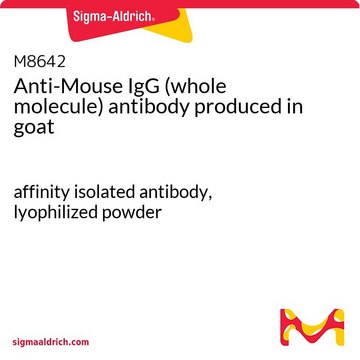76085
Anti-Mouse IgG - Atto 594 antibody produced in goat
~1 mg/mL protein, affinity isolated antibody
Synonym(s):
Atto 594 - goat-Anti-mouse IgG
Sign Into View Organizational & Contract Pricing
All Photos(1)
About This Item
UNSPSC Code:
12352203
NACRES:
NA.46
Recommended Products
biological source
goat
conjugate
Atto 594 conjugate
antibody form
affinity isolated antibody
antibody product type
secondary antibodies
clone
polyclonal
contains
50% glycerol as stabilizer
species reactivity
mouse
concentration
~1 mg/mL protein
fluorescence
λex 603 nm; λem 625 nm in PBS
shipped in
wet ice
storage temp.
−20°C
target post-translational modification
unmodified
Related Categories
General description
Immunoglobulin G (IgG) is a glycoprotein antibody that regulates immune responses such as phagocytosis and is also involved in the development of autoimmune diseases. Mouse IgGs have four distinct isotypes, namely, IgG1, IgG2a, IgG2b, and IgG3. IgG1 regulates complement fixation in mice.
Affinity isolated antigen specific antibody is purified from goat anti-mouse IgG antiserum to remove essentially all goat serum proteins, including immunoglobulin. Goat anti-mouse IgG associates with mouse IgGs.
Affinity isolated antigen specific antibody is purified from goat anti-mouse IgG antiserum to remove essentially all goat serum proteins, including immunoglobulin. Goat anti-mouse IgG associates with mouse IgGs.
Immunogen
purified mouse IgG
Application
Atto 594-goat anti-mouse IgG can be used for fluorescence-based immunoassays.
Analysis Note
unconjugated dye ≤5% of total fluorescence; dye-to-protein ratio ≥2
Legal Information
This product is for Research use only. In case of intended commercialization, please contact the IP-holder (ATTO-TEC GmbH, Germany) for licensing.
Disclaimer
Unless otherwise stated in our catalog or other company documentation accompanying the product(s), our products are intended for research use only and are not to be used for any other purpose, which includes but is not limited to, unauthorized commercial uses, in vitro diagnostic uses, ex vivo or in vivo therapeutic uses or any type of consumption or application to humans or animals.
Not finding the right product?
Try our Product Selector Tool.
Storage Class Code
10 - Combustible liquids
WGK
WGK 1
Flash Point(F)
Not applicable
Flash Point(C)
Not applicable
Personal Protective Equipment
dust mask type N95 (US), Eyeshields, Gloves
Choose from one of the most recent versions:
Already Own This Product?
Find documentation for the products that you have recently purchased in the Document Library.
Customers Also Viewed
Charles Bou-Nader et al.
Cell host & microbe, 29(9), 1421-1436 (2021-08-14)
The HIV-1 virion structural polyprotein, Gag, is directed to particle assembly sites at the plasma membrane by its N-terminal matrix (MA) domain. MA also binds to host tRNAs. To understand the molecular basis of MA-tRNA interaction and its potential function
Mirko Cortese et al.
Cell host & microbe, 28(6), 853-866 (2020-11-28)
Pathogenesis induced by SARS-CoV-2 is thought to result from both an inflammation-dominated cytokine response and virus-induced cell perturbation causing cell death. Here, we employ an integrative imaging analysis to determine morphological organelle alterations induced in SARS-CoV-2-infected human lung epithelial cells.
Barbara Storti et al.
Computational and structural biotechnology journal, 19, 6140-6156 (2021-11-09)
We exploited a multi-scale microscopy imaging toolbox to address some major issues related to SARS-CoV-2 interactions with host cells. Our approach harnesses both conventional and super-resolution fluorescence microscopy and easily matches the spatial scale of single-virus/cell checkpoints. After its validation
Edward M Courchaine et al.
Cell, 184(14), 3612-3625 (2021-06-12)
Biomolecular condensation is a widespread mechanism of cellular compartmentalization. Because the "survival of motor neuron protein" (SMN) is implicated in the formation of three different membraneless organelles (MLOs), we hypothesized that SMN promotes condensation. Unexpectedly, we found that SMN's globular
Shun Hang Chan et al.
Developmental cell, 49(6), 867-881 (2019-06-19)
The awakening of the genome after fertilization is a cornerstone of animal development. However, the mechanisms that activate the silent genome after fertilization are poorly understood. Here, we show that transcriptional competency is regulated by Brd4- and P300-dependent histone acetylation
Articles
Immunoblotting (Western blot transfer) is a common technique in modern proteomics research.
Our team of scientists has experience in all areas of research including Life Science, Material Science, Chemical Synthesis, Chromatography, Analytical and many others.
Contact Technical Service









